MODULE 1
1/104
There's no tags or description
Looks like no tags are added yet.
Name | Mastery | Learn | Test | Matching | Spaced |
|---|
No study sessions yet.
105 Terms
communication
speech+language
process by which participants exchange information and ideas, needs, wants, and desires
requires a sender and receiver
communicative competence
linguistic
of or referring to a language
performance: linguistic competence in actual usage
competence: refers to a users underlying knnowledge of the rules that govern a language
utterance
spoken word, statement, or sound
speech
verbal means of communicating
requires motor control (planning and execution)
phonemes (specific sounds that can be combined in different ways)
suprasegmentals (vocal quality, intonation, stress, tone, rate)
phonemes
specific sounds that make up a language
44 in English
language
socially shared code or conventional system for representing concepts via the use of arbitrary symbols and rule-goverened combinations of these symbols
evolves with specific historical, social, and cultural contexts
dialect is a subcategory of 5 components: morphology, phonology, syntax, semantics, pragmatics
language learning and use is determined by the influence of biological, cognitive, psychosocial, and environmental factors
effective use of language requires an understanding of human interaction, including such factors as nonverbal cues, motivation, and social-cultural roles
constantly changes, evolves, and grows
culture greatly influences language
English has changed and adapted over time via the addition of new words
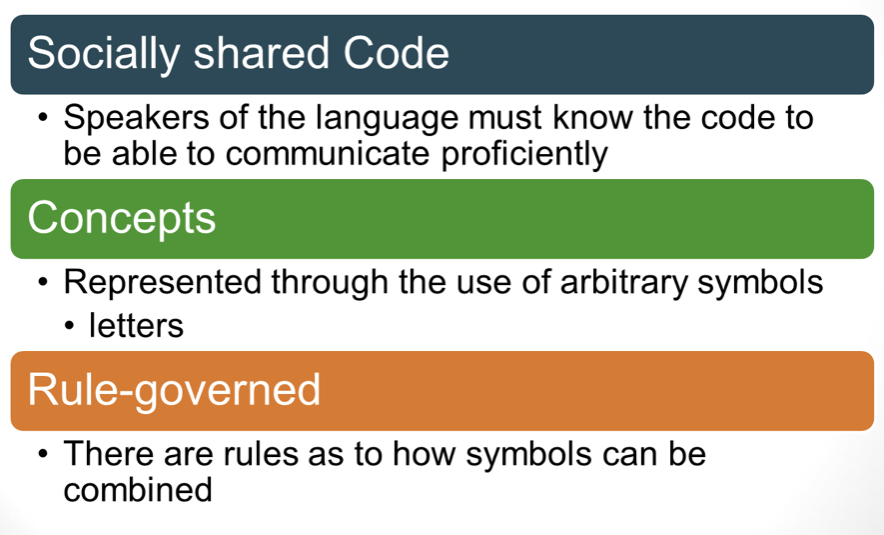
dialect
subcategories of the parent language that use similar but not identical rules
language rule system used by an identifiable group of people that varies in some way from and ideal language standard
language difference, not disorder
it is not regarded as deviant or inferior
factors:
geography
SES
race and ethnicity
situation or context
peer group
first or second language learning
registers: situationally influenced language variations
style shifting: the variation from formal to informal styles and vice versa
morphology
internal organization of words
morpheme = smallest unit of meaning
pragmatics
the study of language in context and as a means to achieve social ends
syntax
form or structure of a sentence
rule governed
phonology
rules that govern the structure, distribution, and sequencing of speech sounds and the shape of syllables
semantic features
aspects of the meaning that characterize the word
selection restrictions
based on these specific features and prohibit certain word combinations because they are meaningless or redundant
vocal play
vocalizations + different sounds
we call this vocal play and is regarded as a precursor to a Childs first word that typically coincides with he first birtgdat
children spend much of their first year experimenting with different vocalization and producing a variety of sounds
ASL
does not mirror standard American english
has its own rules for symbol combination
sign language will change in regards to rules for combining different symbols based on the country where it is used
extralinguistic
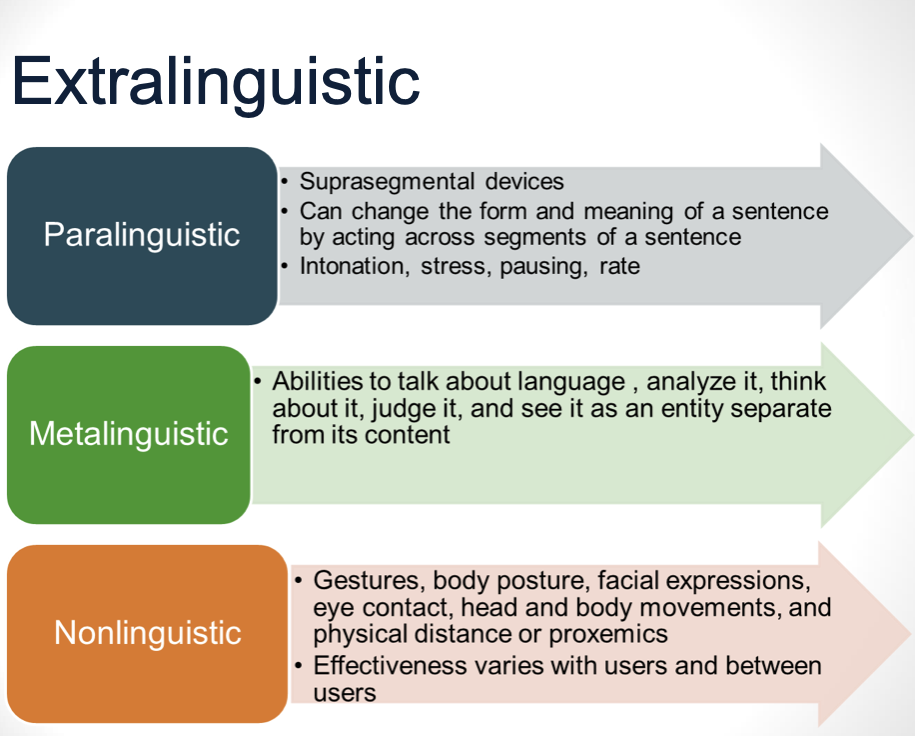
linguistic
modes:
speaking and listening
reading and writing
singing
language characteristics
displacement
rule governed
arbitrary
generative
social tool
syntax
form or structure of a sentence is governed by the rules of syntac
specific word, phrase, and clause order
sentence organization
relationships between words, word classes, and other sentence elements
specifies which word combinations are acceptable, or grammatical, and which were not
morphology
internal organization of words
bound and free morphemes
phonology
concerned with the rules that govern the structure, distribution and sequencing of speech sounds
phoneme
allophone
phonotactics (distribution and sequencing)
semantics
system of rules that govern the meaning or content oft of words and word combinations
each word has 2 parts: semantic features and selection restrictions
some units are mutually exclusive (man and woman)
some unites overlap (female, lady, woman)
includes world knowledge: ones autobiographical and experiential understanding and memory of particular events
includes word knowledge: word and symbol definitions and is primarily verbal
use: pragmatics
study of language in contexts and on language as a communication tool that is used to achieve social ends
includes communication intentions and the number of ways they are carried out, conversational rules, and types of discourse
conversational rules:
turn taking
topic initiation. maintenance, and closing
relevant contributions
providing feedback
providing clarification
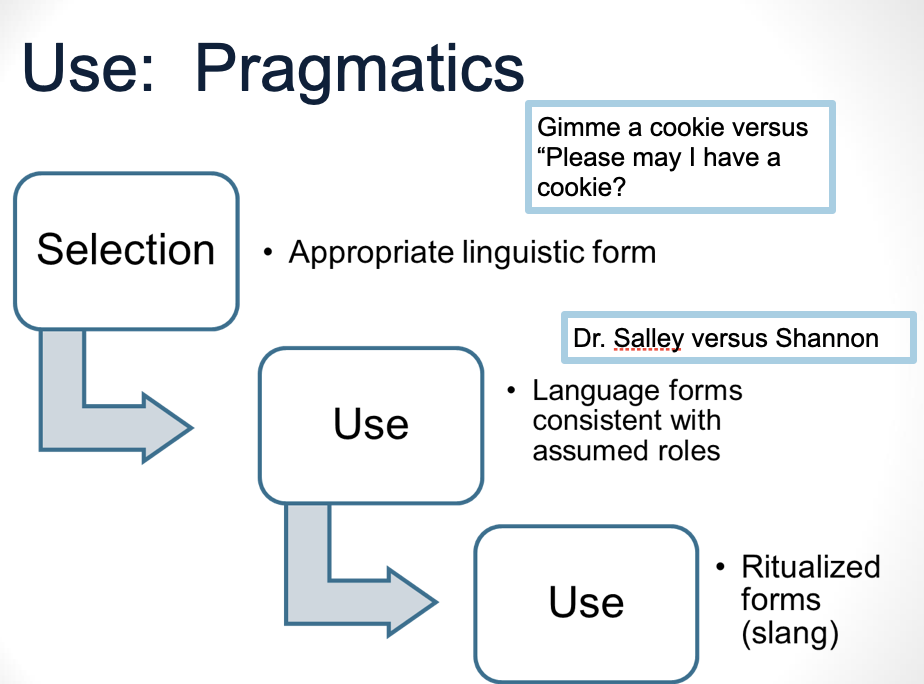
acquisition
generative or nativist approach to language development
nature
nurture
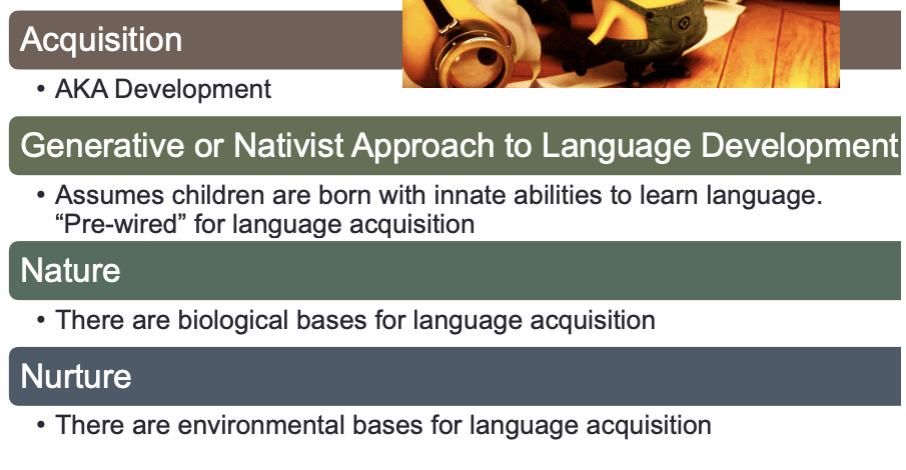
Constructionist or empiricist or interactionist approach
linguistic theory
data
sample
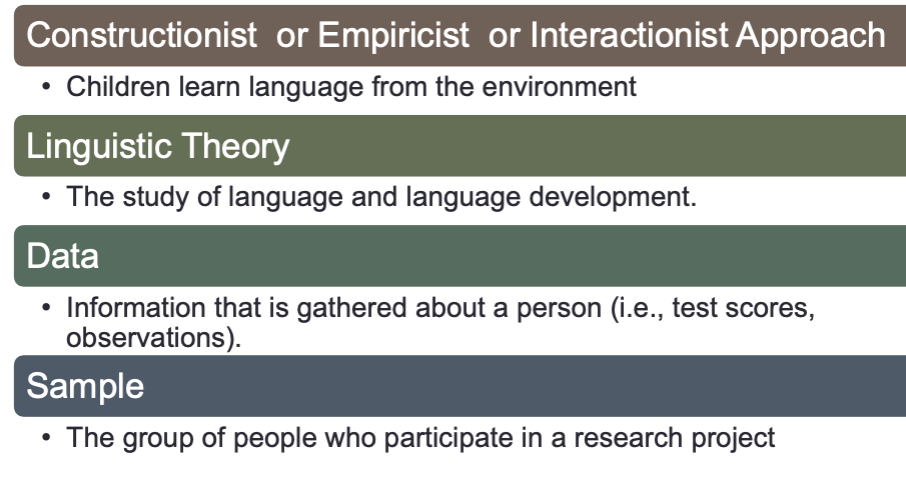
variability
data collection
data analysis
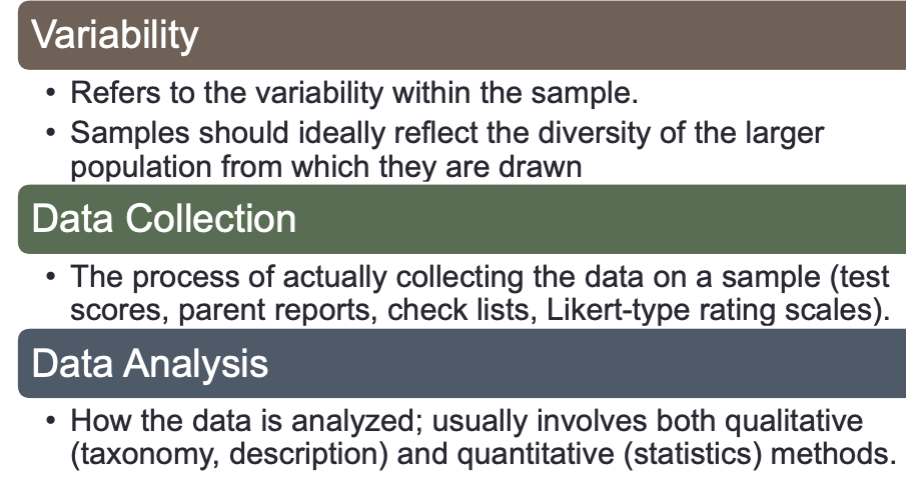
reasons to study language acquisition
concern for human development
facilitate behavior change/learning
increase insight into normal and other than normal language prcesses
help us to understand our own behavior
language development is parallel to cognitive development!!!
theories of language development
nature
generative
nativist
nurture:
constructionist
empirisist
interactionist
generative/ nativist approach
Children learn language because they are born with innate rules or principles related to structures of human languages
Language development is an inherent part of being human
Language is a universal human trait
The environment’s role in a child’s language learning is limited
The Who: CHOMSKY
universal syntactic rules that applied to all human languages
present in all humans at birth
Language acquisition Device:
- proposed that these rules are housed theoretically in the brain
children use the rules found in LAS to figure out the rules of the language to which they are exposed
instead of the subjects and verbs used by adults to produce sentences, children use meaning units
pitfall: while they explain some child utterances, they fail to explain other forms of sentences, such as interrogatives
Constructionist/Empiricist/Interactionist Approach
BF Skinner
parents model language, child imitates it
the child is considered to be contributing member in the language learning process
the child will cue the parent to provide the appropriate language that the child needs in order to learn the language
the environment plays a critical rile in language development
children learn language form the environmental input to which they are exposed
children interact with their environment (parents, caregivers, friends, objects) to learn language
to learn language, children rely upon their cognitive mechanisms
Emergentism
Closely related to both the Nativism and Constructionist Theories
Language development occurs due to interacting patterns in the human brain
There is something in the brain that makes language learning innately possible
The brain depends upon incoming information from the environment in order to seek out patterns
The child finds patterns in the language input they receive.
constructionist/emergentism
Focuses on a usage based approach
it sees language as composed of symbols units that combine form and meaning via the use of morphemes, words, idioms, and sentence frames
Language structure emerges from language use
A child will begin to recognize patterns in the input from the parent, and in turn, beings to use some word-specific combinations
nativist vs constructionist
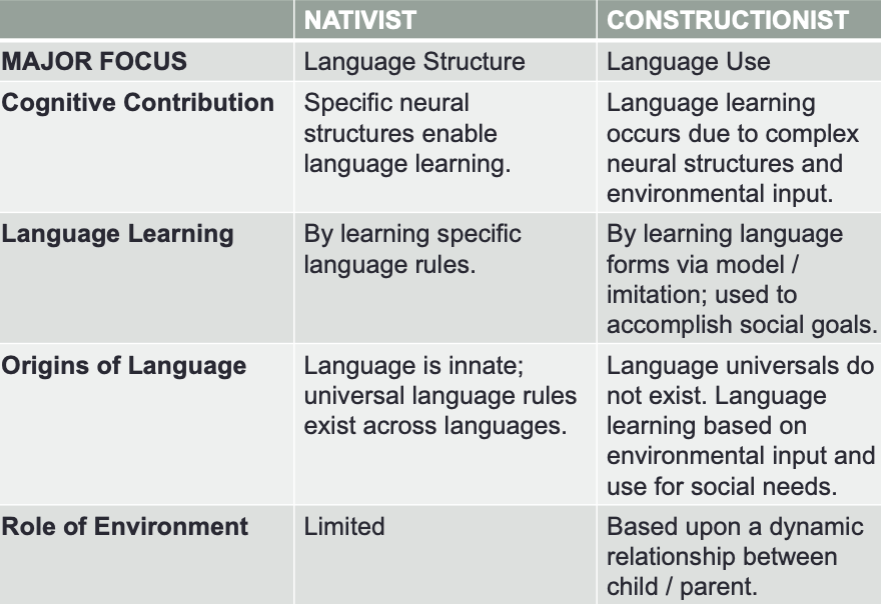
4 goals of language research
To confirm general language development principles
To discover new principles / information about language development
To clarify / expand the relationship between language development and other areas, most notably cognition
To provide a theoretical description oflanguage development
research study designs
longitudinal - a few children are studied for an extended period of time
case study - usually descriptive, one or a few children are included in the data collection
experimental - children are randomly assigned to groups
data collection
Data collection is largely driven by the aspect of language that is being studied
• Speech perception, comprehension, expression
• Expressive language development data are usually
collected in two ways:
1. Conversational (spontaneous) - Usually, a wider variety of language forms
will emerge in conversational sampling
2. Structured testing - More advanced use of language forms will be seen in structured testing
selecting sample size:
Should be large enough to allow for conclusions to be drawn and for generalizations to be made about the greater population from whom the sample was drawn.
Sample size is related to the power of your study
• the number of participants you need in order to be able to generalize your results to many other similar childrenThe sample of children selected for a research study should reflect the diversity of the larger population from which they are drawn
• children should represent the socioeconomic, racial and ethnic, and dialectal variations that are found in the total population.
theory of mind
One’s ability to understand the minds of other people, & to comprehend / predict their behavior
The ability to understand that others have thoughts, beliefs, opinions, emotions that are different from one’s own
awareness that other people have thoughts, beliefs, and feelings, and that these may or may not be the same as the Childs
The nervous system
Innervation or neural control is contralateral, meaning that the right hemisphere controls the left side of the body, and vice versa
neurons
cerebrum
CNS
PNS
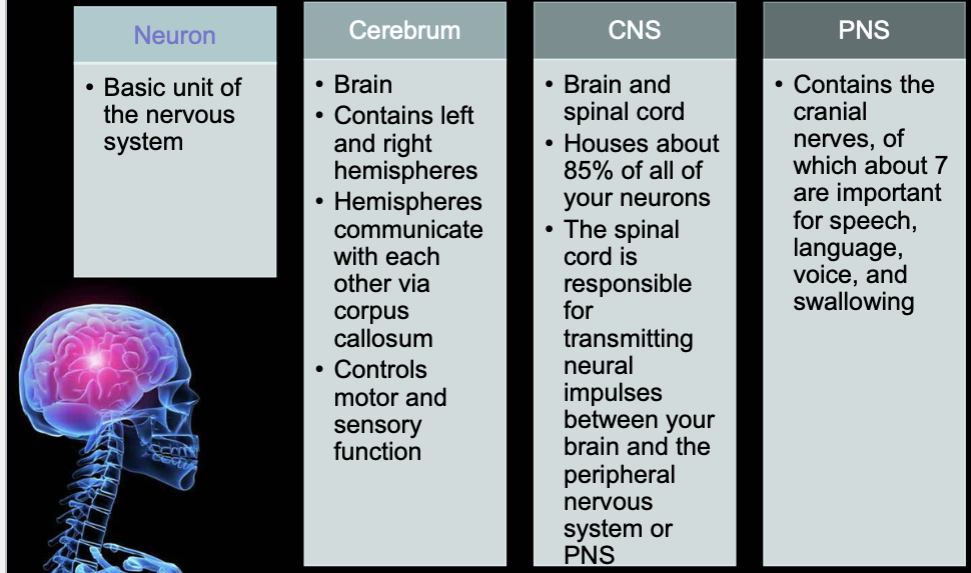
neurons
3 parts
cell body
axon: transmit pulses AWAY from cell body
dendrite: receives impulses form other cells and transmits them cell to body
do not actually touch, bit are close enough to allow neural impulses to “jump” or synapse between the axon of one neuron and the dendrites of the next
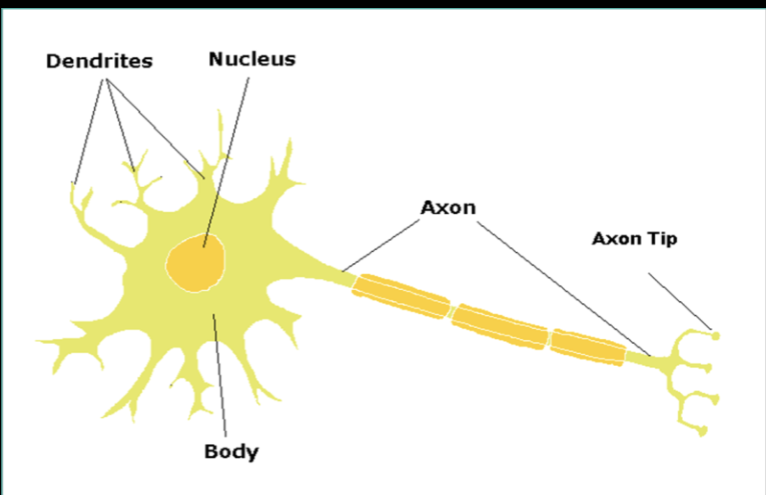
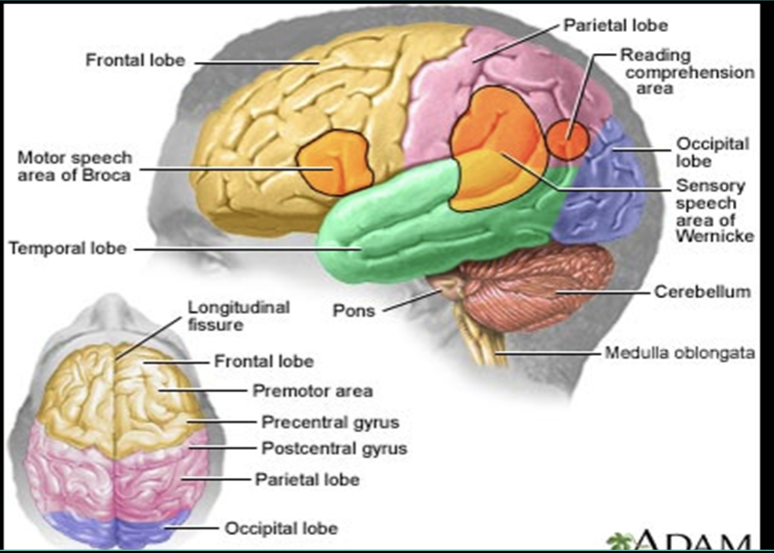
the cerebrum
Each hemisphere of the brain is responsible for different functions, but they also work together via the corpus callosum
For most people who are right handed, the left hemisphere of the brain is dominant for language functions
– expression and comprehension of language
The brainstem
Rests at the top of the spinal cord
• Is responsible for life-sustaining functions:
– respiration or breathing
– heart rate
– blood pressure
– consciousness
– digestion
The reticular formation is a collection of neurons within the brainstem
– controls all sensory information
• including audition or hearing
• vision
• tactile or touch
• other senses
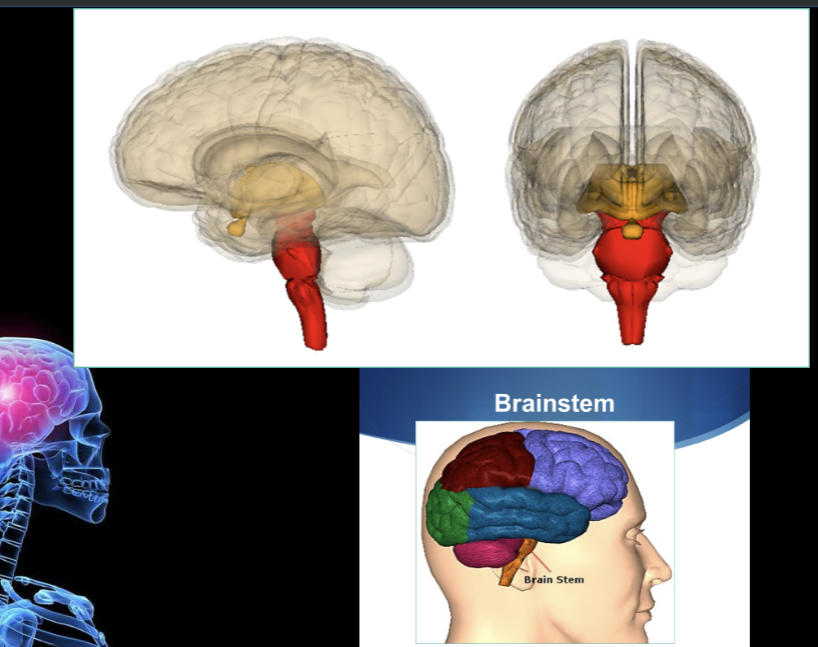
frontal lobe
Most anterior
• Controls voluntary motor function
– including movements for speech production
• Houses Broca’s Area
– a center that is responsible for motor programming and planning for speech production
– is in the language dominant hemisphere (the left in most people who are right handed)
parietal lobe
responsible for sensory information
also important in reading, word recognition, processing both auditory and visual (writing) information
temporal lobe:
processes auditory infrmation
houses wenicke’s area
an area that is responsible for language comprehension
found in the language dominant hemisphere (the left in most people whoa re right handed)
also important in memory
occipital lobe
most posterior lobe
responsible for vision
damages here do not produce deficits in speech, but may interfere with reading and writing skills
right hemisphere
Primarily involved in non-speech tasks, although it does play a role in the ability to use / understand figurative language forms, such as humor / jokes, sarcasm, idioms, and to make inferences
Involved in holistic processing of visual information (recognition of faces, places), speech prosody, music, tones / clicks associated with clocks / alarms, etc., and using / understanding emotional expression
hemispheric Asymmetry
Again, the left hemisphere of the brain is responsible for language production and comprehension in most people who are right handed.
About 60-80% of people who are left handed will also be left hemisphere dominant for language.
The remaining portion of left handers are right hemisphere dominant for language.
Brain maturation
Language development is strongly associated with brain maturation
– Remember, so goes cognition, so goes language!The 1st index of brain development is brain weight
– triples in weight during the first 2 years of life
– By age 12, the brain has reached its full mature weightDuring development, chemical changes in the brain occur, causing the brain to form new channels & to become better organized
Once process that greatly assists in brain maturation is the process of myelination, where the entire nervous system is wrapped in a protective sheath.
– This results in an increase in functioning capacity in the brain.
Language comprehension
Comprehension consists of auditory processing and language decoding
While comprehension processes are generally believed to occur in Wernicke’s Area, it actually involves a number of structures that assist in this process
Processing begins with attending to incoming stimuli, such as the sound of a friend’s voice, the door bell or phone ringing, etc.
Other areas involved in comprehension include:
– Supramarginal gyrus
• Parietal lobe
• Thought to be important in reading and word recognition
– Angular gyrus
• Parietal lobe
• Process auditory and visual[writing] information
– Right hemisphereComprehension also depends on memory storage of both words and concepts
The store of word meanings is diffusely located throughout many areas of the brain, although it is believed to be primarily centered in the temporal lobe.
The hippocampus & amygdala, deep brain structures that are a part of the limbic system, are also very important in memory.
![<ul><li><p><span style="color: #000000">Comprehension consists of auditory processing and language decoding</span></p></li><li><p><span style="color: #000000"> While comprehension processes are generally believed to occur in Wernicke’s Area, it actually involves a number of structures that assist in this process</span></p></li><li><p><span style="color: #000000"> Pro</span><span style="color: #060202">cessing begins with attending to incoming stimuli, such as the sound of a friend’s voice, the door bell or phone ringing, etc.</span></p></li><li><p><span style="color: #060202">Other areas involved in comprehension include:</span><span style="color: #060202"><br></span><span style="color: #060202">– Supramarginal gyrus</span><span style="color: #060202"><br></span><span style="color: #060202">• Parietal lobe</span><span style="color: #060202"><br></span><span style="color: #060202">• Thought to be important in reading and word recognition</span><span style="color: #060202"><br></span><span style="color: #060202">– Angular gyrus</span><span style="color: #060202"><br></span><span style="color: #060202">• Parietal lobe</span><span style="color: #060202"><br></span><span style="color: #060202">• Process auditory and visual[writing] information</span><span style="color: #060202"><br></span><span style="color: #060202">– Right hemisphere</span></p></li><li><p><span style="color: transparent">C</span><span style="color: #000000">omprehension also depends on memory storage of both words and concepts</span></p></li><li><p><span style="color: #000000">The store of word meanings is diffusely located throughout many areas of the brain, although it is believed to be primarily centered in the temporal lobe.</span></p></li><li><p><span style="color: #000000"> The hippocampus & amygdala, deep brain structures that are a part of the limbic system, are also very important in memory.</span></p><p><span style="color: #000000"><br></span></p><p><span style="color: #060202"><br></span></p></li></ul><p><span style="color: #000000"><br></span></p>](https://knowt-user-attachments.s3.amazonaws.com/012224ca-64ff-4ceb-a8f1-b85aa6a9c43d.png)
Language production
Language production processes are located in the same general area of the brain as comprehension processes
Broca’s Area (frontal lobe) is responsible for programming and planning the message that is to be spoken
Signals from Broca’s Area are then sent to regions of the motor cortex for execution by the muscles of speech production
information processing
defined as the way information processed and includes a number of steps
attention → discrimination → organization → memory
attention
includes both awareness of something and active cognitive processing
divided into orientation and reaction
orientation:
the ability to sustain attention over time
motivation and interest play a huge part
reaction
the amount of time required for one to respond to a stimulus
involves ones ability to select relevant parts of a stimulus
attention
In general, less mature individuals are less efficient at attention allocation and have a more limited attentional capacity.
In facilitating language development, how might you adjust an activity for a 6 month old versus a 2 year old versus a 4 year old?
discrimination
Defined as the ability to identify stimuli differing along some dimension
If one cannot identify the relevant characteristics of something, then he / she will have difficulty comparing the new input with stored information
Discrimination, especially for language processing, requires a special type of memory called working memory
Working Memory or WM: A temporary storage for information you have to remember during processing
• WM for most people is about +/- 7 digits
Examples:
– remembering what someone has just said to you.
– remembering a telephone number long enough to
organization
Organization of incoming information is important for later retrieval
Information is organized or “chunked” by category
Poor organization will tax the storage capacity of the brain and hinder memory or recall
mediational:
a symbol forms a link to other information
Associative:
one symbol is linked to another, as in the common linkages of “man” and “woman” and “hot and cold”
memory
Defined as the ability to recall information that has been previously learned and stored
• This is a more permanent type of storage for information
• Information is retained in long term memory via rehearsal or repetition and organization
• Information is best recalled when it is deeply processed
Top down vs Bottom down processing
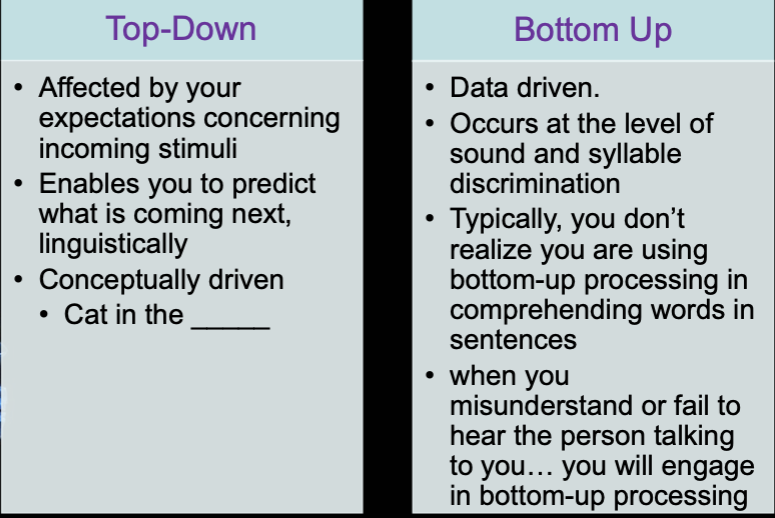
Passive vs active processing
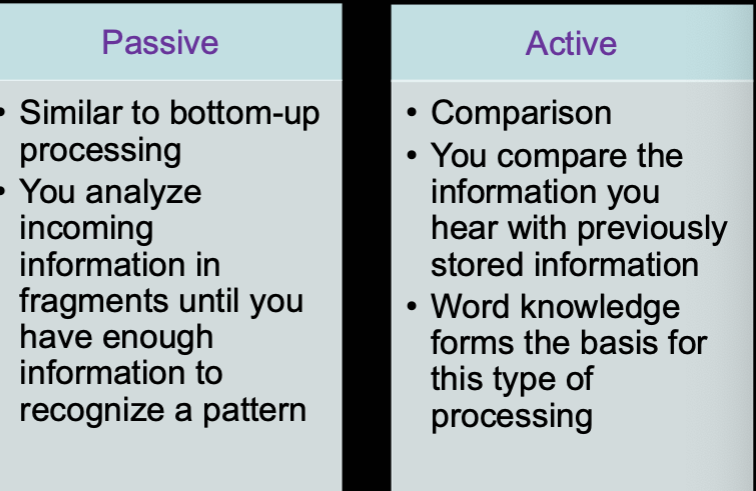
serial vs parallel processing
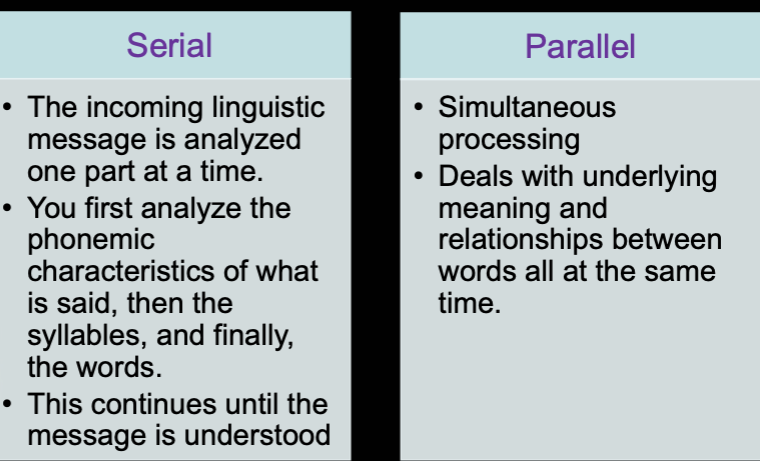
neuro development:
hemisphere development
frontal lobe
myelination and synaptogenisis
memory
speech and language
development altered by
Hemisphere Development
After birth, there is rapid development in the cerebellum and cerebral hemispheres, especially in the visual areas of the occipital lobe
Frontal Lobe
At around 2 months of age, motor control in the frontal lobe becomes more active
During this time, the child is gaining greater control of volitional or voluntary motor behaviors and many reflexes begin to disappear
Myelination and synaptogenesis
In the postnatal period, neurons experience myelination and synaptogenesis or cells communicating with one another
Myelination occurs over many years
Memory
Between the ages of 6 months to 1 year, a child develops
increasing ability to remember stimuli and to make associations between words and the entities to which they refer
Speech and Language
Neural areas devoted to speech / language are fairly mature by late preschool, although higher level cognitive – linguistic functions are no fully mature until well in adulthood
Unknown when lateralization for language occurs – may be present at birth
Development Altered by
Brain development can be altered by a number of environmental influences, including maternal use of alcohol, nutrition, legal / illegal drugs
cognition
Defined as the mental activities involved in comprehension of information, including the acquisition, organization, storage, memory, and use of knowledge
Includes a number of processes, including reasoning, problem solving, learning, and thought
Cognitive development is very closely tied to the emergence of language or language development
At early stages of development, the brain appears to have relatively little in the way of architectural differences
The much greater organization found in adults appears to result from development (maturation) and environmental stimulation
Brain architecture refers to the way various areas of the brain are connected together
Part of brain development – that is, maturation – involves the continued development of many synaptic formations
Experience with the environment is essential for synaptic formation
cognition: timing
Developmental Timing: Defined as the period of time when the brain is receptive to certain inputs and to changes in the brain itself as a result of learning.
During the first 2 months of life, the brain begins to segment into specific regions
Cognition: experience
Early life events have a powerful influence on both the pattern of brain organization and behavioral development
– Both genetics and the environment contribute to this
Sensitive Period: Developmental period that varies for each perceptual and cognitive area during which the brain is more receptive to specific environmental input
– represent a time when an infant’s capabilities can be modified or enhanced
– quality of experiences during this period is extremely important
cognition: memory
The 1st step in long term memory process is organization and storage of perceived information.
Organization is an attempt to bring systematic order to information – this is accomplished via categorizing information.
Information becomes a part of long term storage via a process called rehearsal – repetition, drill, or practice.
Integrative rehearsal occurs when new information is integrated with old information
Vital for acquiring all forms of knowledge, including
language.Infants who have better memory are also better at encoding, storing, consolidating, and retrieving representations of objects and events.
Infants with better recognition & recall memory are better able to link words with referents.
Better recognition & recall at 12 months is strongly associated with better language skills at 36 months
sensation and perception
sensation:
defined as the ability to register or recognize/process sensory information
all senses are functioning at birth
Perception:
defined as using both sensory information and previous knowledge to make sense of incoming stimuli
both use attention!
sensation
Touch is the first sense to develop in utero
A fetus is also sensitive to
sounds very early and will startle to both sounds and movement at about 8 weeksHearing is developed by 20 weeks post- conception & is considered to be fully functional at this point
attention
Defined as the ability to engage, maintain, disengage, and shift focus.
Infants who have better attention are likely to acquire language more quickly.
They are better able to follow the gaze of others, engage in joint or shared attention, and track referents.
Joint or shared attention: Occurs when two individuals – mom and child – attend to the same thing, such as a toy.
Newborns or neonates have difficulty controlling attention or concentrating on a mental activity
Many of an infant’s behavior- state changes reflect internal changes or intrinsic brain activities.
By 2 months of age, an infant will exhibit selecting attending skills and can remain unresponsive to some background or interfering stimulus events
Habituation: Process of becoming used to a stimulus
Habituation
Habituation enables an infant to attend to new stimuli without competition from older, less novel or new stimuli.
This is important in future learning abilities as it ultimately influences one’s ability to stay on task for extended periods of time
perception
the ability to discriminate differences in incoming information is a part of perception
It is a process of gaining awareness of what is happening around us
Visually, an infant is able to recognize mom’s face within a few days of birth
By 3 months, an infant can perceive facial differences, and in general, will respond more positively to a smile
As memory increases and after repeated exposure to a stimulus (person, toy), the sight of the stimulus will elicit signs of recognition
of importance is the influence of auditory perceptual skills on speech and language development
In order for an infant’s auditory perceptual skills to develop, he / she must be exposed to auditory stimulation from the environment
Newborns are capable of many different types of auditory discrimination: different sound durations, different loudness levels, different phonemes & consonants in short syllables
Newborns are also able to discriminate between different
pitches, especially in the human speech rangeBy 2 months, they can discriminate frequency changes, such as high to low
By 7 months, infants can discriminate different words
Neonates preferhuman speech to other nonlinguistic auditory stimuli and by 3 months of age, they seem to be more attentive to words
Development of speech perception proceeds through the 1st year of life
Newborns are capable of detecting virtually every phoneme contrast used in a language
With exposure to language, an infant begins to recognize patterns in the language
The ability to detect patterns & to
make generalizations is very
important for later symbol and
language rule learning.
• Strong associations exist between
speech perception at 6 months of
age and later word understanding,
word production, and phrase /
sentence understanding.By 5 months of age, most
children will respond to their own
name & to either mommy or
daddy.
Between 8 – 10 months of age,
changes in perception &
production occur & are thought to
be related to brain development,
especially synaptogenesis or a
burst in synaptic growth.
• During this period, imitation of others and
intentional (“on purpose”) communication
emergesBy 8 months of age, infants
develop an understanding of
phonotactic regularities,
defined as the ability to
recognize phonemes,
phoneme combinations, and
syllable structures of their
native language.
Infants also develop the
ability to recognize frequently
occurring language patterns,
called phonotactic
probabilities, or the likelihood
that certain sounds, sound
sequences, and syllables will
occur.
motor control
Defined as muscle movement and the sensory feedback that informs the brain of the extent of that movement
A neonate is unable to control motor behavior smoothly and voluntarily
– Movements consist of twitches, jerks,random movements, most of which
involve automatic, involuntary motor patterns called reflexesHand to face contact and body rotation are seen at 10 weeks in utero
Early vocalizations are controlled by the brainstem.
Maturation of the pathways that link auditory and motor areas with speech areas is not achieved until the 2nd year.
reflexes
Reflexes disappear or are modified by around 6 months of age
– largely due to the process of myelination
• The suck – swallow pattern is of most interest for speech development
– It is established at 6 months post-conception
– Infants begin with up / down movement & progress to lateral jaw movements within a few weeks
suck-swallow reflex
In order to suck, the neonate must:
• be able to seal off the oral from the nasal cavity to prevent nasal regurgitation.
• also be able to close the vocal folds in order to protect the airway during swallowing
motor control: early vocalizations
Vocalizations produced by a newborn consist of reflexive sounds, such as fussing and crying.
Quasi-resonant nuclei (QRN) are non-crying sounds that usually accompany feeding or in response to some stimuli or talking by mother
– QRN contain phonation, or vibration of the vocal folds, but the child does not have sufficient control of the vocal mechanism to produce either consonants or full vowels
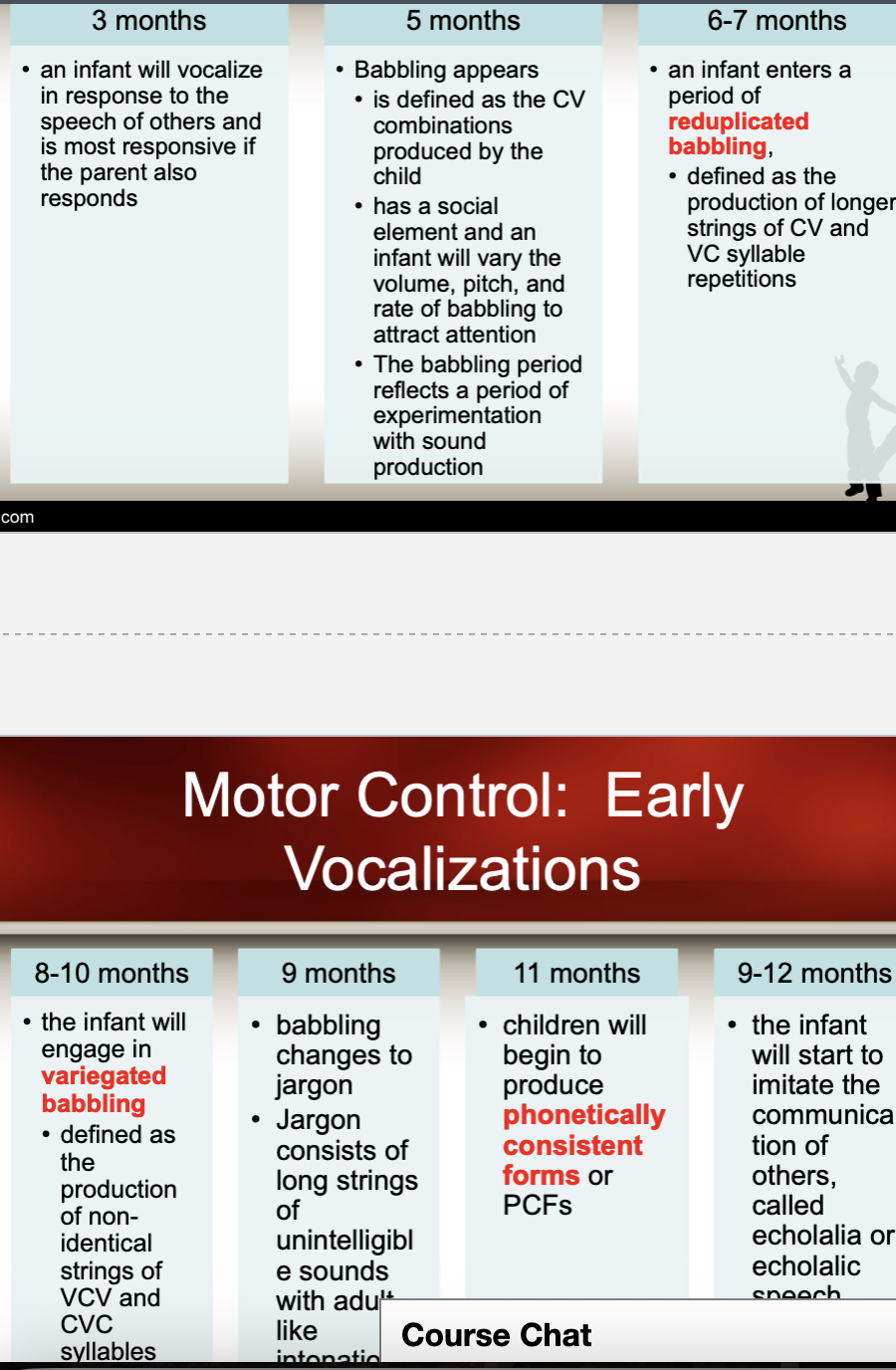
PCFs
Function as words for a child, even though they are not based on adult words.
Unlike babbling, a PCF has consistent prosodic and speech-sound patterns, such as “ba-ki” that is used by a child to refer to a specific entity, such as his / her blanket.
Are considered to be the link between babbling and adult like speech in that they are more limited than babbling but not as phonologicallystructured as adult speech.
Also reflect a child’s understanding of sound- meaning relationships.
Early vocalizations considerations
First sounds are restricted to plosives, such as p, b,t, d, g, k; nasals (m, n, ing); & /j/.
– also represent about 80% of the consonants in infant vocalizations AND the first 50 words produced.
• Hearing or audition is very important during this period
– A deaf child will decrease the range of consonants within babbling, especially after 8 months of age.
representational competence
Defined as the ability to extract commonalities from experiences and represent them abstractly or symbolically
These abilities are the way in which an infant establishes relations between words and referents
– it is necessary for language developmentThese abilities are seen in an infant’s anticipation of future events, object permanence, and in symbolic play
Mental Maps: Refers to the linking of concepts together to related, stored information.
An infant will cognitively evaluate and compare different stimuli – mom’s face, toys, etc.
– This gives rise to the formation of concepts or schemes that give infants an expectation about the properties of objects, events, and people in the environment.There is a strong correlation between the number of words heard by a child during early development and the cognitive abilities of that child, even into late preschool years
At about 7 months, infants begin to understand 1 – 2 single words.
At 9 – 13 months, children understand words based on a combination of sound, nonlinguistic cues, and context.
learning
Begins very early
A child experiences & learns from the environment via others (adults, older siblings)
The ability to learn new tasks & to retain this learning increases with age.
– A 2 month old can retain previously learned motor skills for
a few days
– a 6 month old can recall learning from the past 2 weeks
– a 1 year old can recall from the past 8 weeksAs an infant develops, his / her conceptual system will change
The system consists of organized patterns called
schemes or concepts.
– Schemes are basically used to process new, incoming information
– When new information conflicts with a scheme, then that scheme
is modified or replacedIt is important to note that cognitive development is not a quantitative accumulation of ideas & facts, but rather, it is the qualitative change in the process of thought (just like our “cat” example).
In general, all cognitive development is the result of organization and adaptation
learning principles
Organization
-to systematize or organize information into systems
Adaptation
- Function or tendency of all organisms to change in response to the environment
Equilibrium
- State of cognitive balance or harmony between incoming stimuli & your cognitive structures.
Assimilation
• Use of existing schemes to incorporate external stimuli.
• Example: Both German shepherds & Irish setters are different, but share enough characteristics to belong to the category of dog.
Accommodation
• The transformation process that occurs when external information does not fit into any available scheme and as such, cannot be assimilated.
maternal techniques for infant participation
phasing
adaptive
facilitative
elaborative
initiating
control
paralinguistic cues
communicative competence
cultural competence
nonlinguistic cues
cerebellum
central and lateral sulcus
corpus callous
synaptogenesis
myelination
prefrontal cortex
motor cortex
integration
properties of language